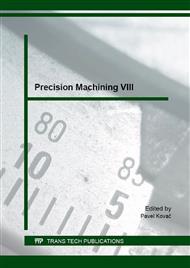[1]
O. Bílek, J. Javořík, J. Čop, Comparative machinability and surface integrity in grinding of titanium, Int. J. Mech., 9 (2015), 43–52.
Google Scholar
[2]
R. Čep, A. Janásek, J. Petrů, M. Sadílek, P. Mohyla, J. Valíček, M. Harničárová, A. Czán, Surface Roughness after Machining and Influence of Feed Rate on Process, Key Eng. Mater., 581 (2013), 341–347.
DOI: 10.4028/www.scientific.net/kem.581.341
Google Scholar
[3]
F. Holesovsky, M. Novak, F. Chinesta, Y. Chastel, M. El Mansori, Grinding and its influence to ground surface durability, in International Conference on Advances in Materials and Processing Technologies (AMPT2010), 2011, p.973–978.
DOI: 10.1063/1.3552579
Google Scholar
[4]
Y. L. Hou, C. H. Li, G. Y. Liu, Investigation into High-Speed/Super-High Speed Grinding, in Advanced Materials Research, 2011, p.4108–4111.
DOI: 10.4028/www.scientific.net/amr.189-193.4108
Google Scholar
[5]
I. Lukovics, J. Čop, L. Fojtl, P. Lukovics, V. Pata, Prediction of surface product quality and operation reliability of grinding machines, Manuf. Technol., 14 (2014), 213–217.
DOI: 10.21062/ujep/x.2014/a/1213-2489/mt/14/2/213
Google Scholar
[6]
S. Malkin, C. Guo, Thermal Analysis of Grinding, CIRP Ann. - Manuf. Technol., 56 (2007), 760–782.
DOI: 10.1016/j.cirp.2007.10.005
Google Scholar
[7]
L. Novakova-Marcincinova, J. Novak-Marcincin, M. Janak, Precision Manufacturing Process of Parts Realized by FDM Rapid Prototyping, Key Eng. Mater., 581 (2013), 292–297.
DOI: 10.4028/www.scientific.net/kem.581.292
Google Scholar
[8]
J. F. G. Oliveira, E. J. Silva, C. Guo, and F. Hashimoto, Industrial challenges in grinding, CIRP Ann. - Manuf. Technol., 58 (2009), 663–680.
DOI: 10.1016/j.cirp.2009.09.006
Google Scholar
[9]
W. B. Rowe, Principles of Modern Grinding Technology, vol. 11. Elsevier Science, (2013).
Google Scholar
[10]
A. Vajdová, A. Micietová, M. Neslušan, and K. Kolarik, Analysis of surface integrity of parts after non conventional methods of machining, Manuf. Technol., 14 (2014), 470–474.
DOI: 10.21062/ujep/x.2014/a/1213-2489/mt/14/3/470
Google Scholar
[11]
M. Bachratý, M. Tolnay, M. Králik, Hodnotenie kvality reznych kvapalin energetickou bilanciou, in Mezinarodni konference vyrobnich technologii pri prilezitosti 50. vyroci zalozeni Katedry obrabeni a montaze Fakulty strojni VSB-TU Ostrava, Ostrava, (2014).
Google Scholar
[12]
Information on http: /www. plasticseurope. org.
Google Scholar


